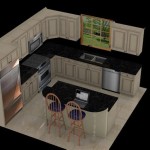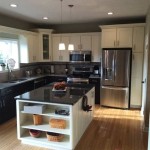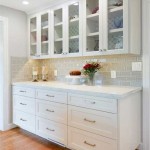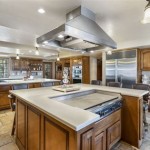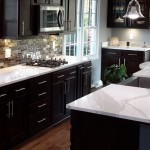```html
Hardwood Floors or Tile in Kitchen: A Comprehensive Comparison
Selecting the appropriate flooring for a kitchen renovation or new construction project requires careful consideration of various factors. Two popular choices, hardwood and tile, each offer distinct advantages and disadvantages in terms of aesthetics, durability, maintenance, and cost. Understanding these differences is crucial for making an informed decision that aligns with individual needs and preferences.
The kitchen environment presents unique challenges to flooring materials. Exposure to moisture, spills, heavy foot traffic, and potential impacts from dropped objects necessitate a material that can withstand such conditions while complementing the overall design of the space. Both hardwood and tile possess qualities that make them suitable for kitchens, but their performance varies significantly under specific circumstances.
Aesthetic Considerations: Wood's Warmth vs. Tile's Versatility
Hardwood flooring introduces a sense of warmth, natural beauty, and timeless elegance to a kitchen. The variety of wood species, stains, and finishes available allows for a high degree of customization to match existing cabinetry, countertops, and décor. Hardwood can create a seamless transition between the kitchen and adjacent living areas, particularly if hardwood flooring is already present in those spaces.
Tile, on the other hand, offers unparalleled versatility in terms of design. Available in a virtually limitless array of colors, patterns, sizes, and textures, tile can be used to create a diverse range of aesthetic effects, from rustic and traditional to modern and minimalist. Tile can emulate the look of natural stone, wood, concrete, or other materials, providing numerous design options at potentially lower costs than the genuine article.
The choice between hardwood and tile often hinges on the desired aesthetic and the overall design concept. Hardwood is generally preferred for creating a warm, inviting, and cohesive look, while tile is favored for its ability to create bold statements, intricate patterns, and customized designs.
Durability and Maintenance: Resistance to Moisture and Wear
One of the primary concerns regarding hardwood flooring in kitchens is its susceptibility to moisture damage. Water spills, leaks from appliances, and even high humidity can cause hardwood to warp, stain, or rot. While engineered hardwood (comprising layers of wood veneer over a plywood or fiberboard core) offers improved moisture resistance compared to solid hardwood, it is still not impervious to water damage. Proper sealing and immediate cleanup of spills are essential for maintaining the integrity of hardwood flooring in a kitchen environment. Furthermore, hardwood is susceptible to scratches and dents from dropped objects or heavy foot traffic. Refinishing may be required periodically to restore its original appearance.
Tile, particularly porcelain tile, is exceptionally durable and resistant to moisture, stains, scratches, and impacts. Properly installed tile is virtually waterproof, making it an ideal choice for kitchens where spills and moisture are common. Tile is also easy to clean and maintain; regular sweeping and occasional mopping are typically sufficient to keep it looking its best. The grout lines between tiles, however, can be susceptible to staining and may require periodic cleaning or resealing to prevent discoloration and mold growth.
The durability and maintenance requirements of hardwood and tile must be carefully considered, particularly in high-traffic kitchens or households with young children or pets. Tile offers superior resistance to moisture and wear, while hardwood requires more diligent maintenance to prevent damage.
Cost Considerations: Initial Investment and Long-Term Expenses
The initial cost of hardwood flooring can vary widely depending on the species of wood, the grade of lumber, and the complexity of the installation. Solid hardwood flooring typically costs more than engineered hardwood. Installation costs can also vary depending on the subfloor preparation required and the complexity of the installation pattern.
The cost of tile also varies depending on the type of tile, the size and complexity of the installation, and the cost of grout and other materials. Porcelain tile generally costs more than ceramic tile. Installation costs can be influenced by factors such as the size of the tile, the complexity of the pattern, and the condition of the subfloor.
In addition to the initial purchase and installation costs, long-term maintenance expenses must also be considered. Hardwood flooring may require periodic refinishing to remove scratches and restore its original luster. Tile, on the other hand, generally requires less maintenance over its lifespan, although grout lines may need to be cleaned or resealed periodically. The lifespan of both materials is considerable; a well-maintained hardwood floor can last decades, while tile can potentially last indefinitely.
The overall cost-effectiveness of hardwood and tile depends on a variety of factors, including the initial investment, the cost of maintenance, and the expected lifespan of the flooring. While hardwood may require more upfront investment and ongoing maintenance, its aesthetic appeal and potential increase in home value may offset these costs. Tile, on the other hand, offers a more durable and low-maintenance option, which may be preferable for those seeking a long-lasting and cost-effective flooring solution.
Beyond the core elements of aesthetics, durability, and cost, several other factors can influence the choice between hardwood and tile for kitchen flooring. These include subfloor conditions, climate, and personal preferences.
Subfloor conditions play a critical role in determining the suitability of different flooring materials. Hardwood flooring typically requires a solid, level, and dry subfloor. Uneven or unstable subfloors can lead to problems such as warping, squeaking, or cracking. Tile also requires a stable subfloor to prevent cracking. Concrete subfloors are generally well-suited for tile installation, while wood subfloors may require additional reinforcement to support the weight of the tile.
Climate can also influence the choice of flooring material. In humid climates, hardwood flooring may be more susceptible to moisture damage. Tile, on the other hand, is unaffected by humidity and can be a more practical choice in such environments. Thermal conductivity is another climate-related factor to consider. Tile tends to be colder to the touch than hardwood, which may be a disadvantage in colder climates. However, tile is also a good conductor of heat and can be used with radiant floor heating systems to provide warmth and comfort.
Ultimately, the decision to choose hardwood or tile for kitchen flooring is a personal one that should be based on a careful assessment of individual needs, preferences, and budget. Consulting with a flooring professional can provide valuable insights and guidance in selecting the most appropriate material for a specific kitchen design and lifestyle.
```
Tile Vs Hardwood Floors In The Kitchen Calypso Country

Hardwood Vs Tile Kitchen Flooring A Comprehensive Comparison Ranney Blair Weidmann

Tile Vs Hardwood Which Is The Best Option For Your Kitchen

Hardwood Flooring Vs Ceramic Tiles Ambience

Hardwood Vs Tile Kitchen Flooring A Comprehensive Comparison Ranney Blair Weidmann

What Looks As Good And Wears Better Than Wood Floors Tiles The Denver Post

Hardwood Flooring Vs Tile For The Kitchen Which Is Best

Kitchen Floor Dilemma Tile Vs Hardwood

Tile Vs Hardwood Floors In The Kitchen Calypso Country

When Wood Floors Meet Tile Important Tips You Can T Miss


